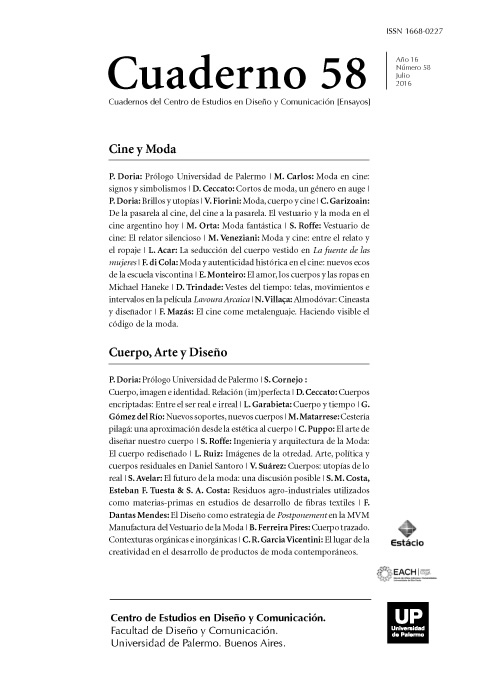Brillos y utopías
Abstract
Fashion magazines announce future trends and also are nurrished by stories from the past. Cinema, as an expression of culture, is and has been featured in countless inspirations within the world of fashion. Here I stop to think about the title “brightness and utopias”; the different effects of light on materials determine different connotations in the visual and cultural record of individuals. By variations of visual perception in clothing also are varying feelings of seduction, power, concealment, protection, glamour, dehumanization, body selection and connotation. That game of perceptions that combines transparency, brightness, opacity and translucent built the appearance that serve as a means or nexus in the visual representation of the individual and his relationship to the other through the indumentum. Cinema in the 20s and 30s, became a display of glamour through jewels, metallic embroidery and glitter. In the 50’s and 60’s ideal future is a space fantasy that emulates the aesthetic that gave the comic science fiction. These resources coupled with the concept of luxury, future, space travel and discovery, provide the arguments for designers inspiration and original presentations on the runways.
References
Baudrillard, J. (1974a). La sociedad de consumo: sus mitos, sus estructuras. Barcelona: Plaza & Janés.
(1974b). La economía política del signo. Madrid: Siglo XXI.
(1969). El sistema de los objetos. México: Siglo XXI.
Dyhouse, C. (2010). Glamour: mujeres, historia y feminismo. London: Claridad S.A.
Hollander, A. (1978). Seeing through clothes, NY: Viking Press.
Veblen, T. (1974). Teoría de la clase ociosa. México: Fondo de Cultura Económica.
Los autores/as que publiquen en esta revista ceden los derechos de autor y de publicación a "Cuadernos del Centro de Estudios de Diseño y Comunicación", Aceptando el registro de su trabajo bajo una licencia de atribución de Creative Commons, que permite a terceros utilizar lo publicado siempre que de el crédito pertinente a los autores y a esta revista.


